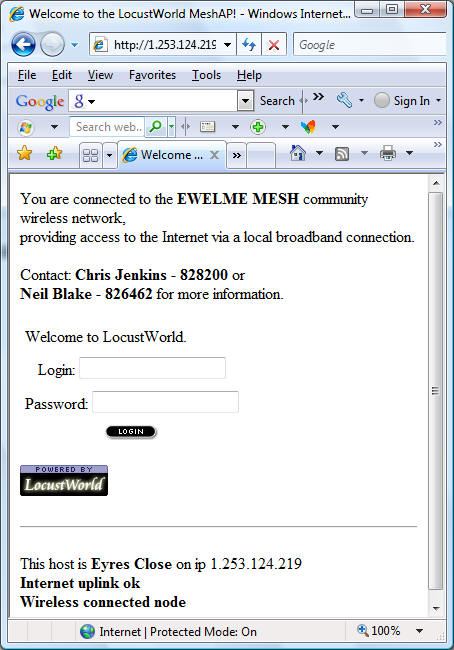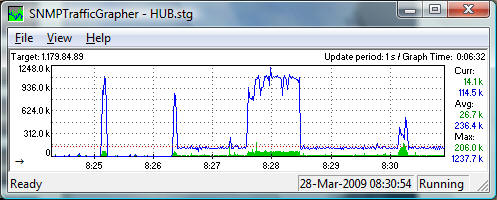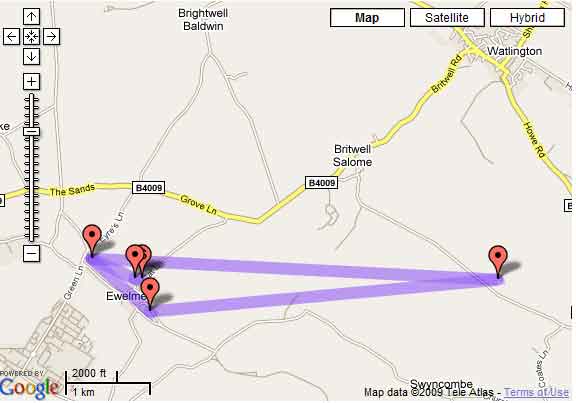Ewelme Wireless Broadband
This page describes some personal experiences of an active involvement in the evolution, use, expansion and maintenance of a local wireless network, to provide community Broadband connections to the Internet.
Node Aerial Eyre's Close |
A few years ago (2005), a local resident - Adrian Powell, issued an invitation in the then far less professional version of the Ewelme News, for anyone wanting to get a broadband connection to the Internet to contact him, with a view to setting up a local trial using WIRELESS. He had previously set up a company called South Oxfordshire Broadband as a commercial enterprise, to provide a service to areas where, at that time, British Telecom were thought not to be interested in investing in the necessary physical improvements in rural areas/villages, where it was difficult to achieve BB by landline. Adrian first had to obtain a high speed means of communicating with the Internet for sharing amongst many users. This he did by renting a 'leased line' from BT via the Watlington exchange (a significant annual financial commitment). It was very fortunate, for Ewelme at least, that Mike Bell at the elevated location of Britwell Hill Farm, had also expressed an interest in being involved in the trial, and having magnificent views of the surrounding Oxfordshire countryside. So, this was the prime 'node' site for relaying a wireless signal from SOB's office in Watlington, firstly to provide Mike with a broadband connection himself, but more importantly to beam it down to Ewelme and other villages in the vicinity. I was also keen to be involved in the trial, not only to just obtain this long sought-after service, but because I happened to be professionally involved in industrial networking (fieldbus) technology, and wanted to expand my knowledge base of wireless standards. We were also fortuitously in line of sight with Britwell Hill Farm (BHF), here in Eyre's Close, making this location quite suitable for another wireless node. Adrian happened to live in Green Lane, and so via his own node and roof dipole aerial, was able communicate with the leased line using a couple of wireless hops.
|
|
Linux Based Wireless 'Node' Box |
Another interested party for the trial was Neil Blake in Chaucer Court. He has a barn, which potentially had line of sight with Eyre's Close, and so another node was fitted there. However, following some initial tests, it was found that just like BHF, a directional aerial was required to ensure a 'mesh' could be maintained with the other nodes in the network. Other sub-systems or Realms were also being set up by SOB in other villages, but are not part of this story.
|
|
Barn Directional Aerial |
Now, all 'nodes' or wireless access points (AP) within this new local Wireless Network, were the means for local 'clients' (households, including the node holders) to also link in with the network. This meant that the 'black box' node computers, which incidentally run using the 'open' and free Linux operating system (as opposed to the proprietary and expensive Microsoft Windows), have to be left powered at all times. Clients are basically personal computers either having built in wireless hardware, e.g. Intel Centrino in laptops and netbooks, or some kind of wireless card or USB wireless adaptor for desktop PCs or older laptops. So, following an initial trial, which mainly involved the voluntary node holders, all users started to begin to pay for the service. Unfortunately, for SOB and Adrian Powell in particular, it was discovered that BT were not completely ignoring rural areas after all, and where originally, areas such as Stadhampton, Chalgrove, Benson and Ewelme were not going to be updated for a broadband service, suddenly their associated exchanges were being enabled. The fact that residents in these areas were now starting to be told that they were capable of receiving land line based broadband (mainly by Indian call centres!), immediately caused the business plan of expanding the wireless network, in terms of increased WiFi subscribers, to become an uneconomic proposition. The upshot was that SOB was wound up and in the fullness of time Adrian and his family happened to move away from Ewelme to Lamborne (and then again to Hungerford).
In the meantime, for the original 'trialists' within the Ewelme realm, this was all somewhat of a tragedy, in that they had all experienced the significant advantages of broadband in terms of an 'always connected' service without the drudge of the dial up procedure, and more significantly, the speed. It was most fortunate that Neil Blake, being closest to the central BT box near King's Pool, was able to take up the offer of a local landline connection, albeit at the slowest rate possible that could still be defined as 'ADSL' (500kbs). For my own part, I already had an ISDN connection (a precursor to broadband, with faster connection and data speed than dial-up modems), that I had brought with me from my Wallingford office. I initially had horrendous problems when I first set up shop here, because it was found that the new office line provided was not of sufficient quality to sustain a connection. Following threats of court action on the basis that a previous BT survey had confirmed that transfer of my ISDN line from Wallingford to my new office was possible, BT dug up our front lawn and installed a new spur from a pavement box. It worked! However, in also applying for broadband on the basis of the many unsolicited phone calls insisting I could have it, it came to nothing, and it was pretty obvious why - line quality. Anyway, rather than sourcing broadband from the leased line in Watlington, the evolved local wireless network now had a domestic connection to the internet from Chaucer Court. Adrian Powell agreed to sell and leave the remaining equipment to the node holders, and kindly continued to be locally and remotely involved in ensuring that the wireless connection from Neil's barn to his ADSL router was stable. After trying a secondary wireless network and even a mains borne data connection, it was found that the best solution was to incorporate another node into the network in the loft of Neil's house (also a converted barn - Northbarn) . Now rather than the final link to the broadband router being by wireless, this was achieved using a wired connection called Ethernet. This has been a wholly robust configuration now, for what I refer to at least, as the 'Ewelme Mesh' (an electromagnetic 'meshing' of wireless nodes), or the Ewelme Community Wireless Network, for a number of years.
|
|
| USB Wireless Client Adaptor with Extendable Aerial |
As far as the Ewelme Community Wireless Network is concerned, the application software that runs within the personal computer type hardware under Linux, has been designed and distributed by 'LocustWorld', and this is the 'SSID' you would see when looking for wireless networks to use.
|
Unauthorized 'Clients' searching for a wireless network will see this Log on Splash |
This software takes operational care of meshing together the included nodes via the inbuilt wireless cards, and provides a means of configuring the nodes in terms of channel settings, transmitter power etc. and provides an ability to test and reboot the machine using a secure command protocol (ssh) and/or via a graphical table using a web browser (html). The great advantage of such a set up, is that it can be monitored and controlled from outside the network itself using a variety of network administration tools. An international wireless networking 'authority' called Wiana is the means of obtaining unique IP addresses for each publicly accessible wireless node box. It also provides a means for network administrators to utilize provided services for authorizing new 'members' of the network, and obtaining data on a regular basis 24/7 on usage, serviceability and even the temperature of the box!
|
Graphical Monitoring Utility Showing Traffic Through a Node |
Certainly, all these facilities have been used on many occasions in attempting to keep the system up and running, even to detecting on one occasion that a change in the current 'dew point' was the cause of a 'dropout' between two nodes. It later transpired that this was due to just a little too much interference from another wireless network on an adjacent channel! Changing all nodes to another channel immediately alleviated the problem. It has to be said however, that the development of the expertise to deal with such problems over the last few years, would not have been attained without the initial and continuing encouragement of Adrian Powell.
 |
Command Line Monitoring of Signal Levels |
So, what is the current state of the Ewelme Mesh? Apart from Mike Bell at BHF, myself and Neil Blake, most of the residents of Eyres Close have at one time or another had access to the Internet via this wireless network. Since a new 'quality' cable was laid between Wallingford Bridge and Ewelme (Kingspool), providing an additional 50 pairs capable of providing a low attenuation ADSL service (another story - see www.ewelme.info ), some have been able to get broadband themselves and don't require the service anymore. But others have still not been able to get it, either because the quality of the line from Kingspool is still questionable, or because all the additional new cores have been snapped up. I guess that because of the work that had been done on my ISDN line, I was one of the lucky ones, and got my own broadband line some while ago. What this does mean though, is that there are two routes that Ewelme Mesh signals can take to the Internet rather than just one. This means that if there are problems at the Chaucer Court router, the Mesh 'gateway' can be switched to Eyre's Close. Probably one of the bonuses of the cable upgrade was that the operational speed of the Mesh increased to around 1Mbs. This can be tested by users by using http://www.mybroadbandspeed.co.uk/ in a web browser. There are currently four 'clients' in Eyre's Close, where client adaptors vary from USB 'dongles' on extension leads, to the straightforward use of a wireless enabled laptop.
Not so long ago, a potential 'client' in Martyn's Way requested that he have a trial to establish whether he could join the group, being in line of sight of a node location. Such a test was successfully carried out using a redundant wireless card in his desktop PC, where an extension aerial was initially 'hung' out of the window to pick up signals from the Northbarn loft node. Another 'client' (next door) has had a USB client fitted, but this time with a high gain indoor aerial extension positioned to obtain a sufficiently strong signal to also be able to join 'The Mesh'.
A few weeks before this, a new node was installed in the belfry of Ewelme Church with a 'dipole' aerial attached to the weather vane.
|
|
Church Node Aerial |
This was initiated because the new vicar also wasn't able to to get broadband. However it later transpired that he was able to obtain a connection after all, although no-one can really understand why? (I must try praying a bit more!).
Client high gain aerial linked to Church |
However without the new church node, a couple of newly created potential clients in that vicinity, would not have been able to join. This now makes ten 'subscribers'. Perhaps a more meaningful statistic is that authority has been registered for 18 individual wireless devices to use the wireless network. Apart from contributing to the cost of Neil's broadband connection and any special hardware required, it is hoped that any surpluses from these members' contributions can be paid into Ewelme Church funds or some other village good causes.
|
Map showing the location of the 5 nodes of the Ewelme Community Wireless Network |



